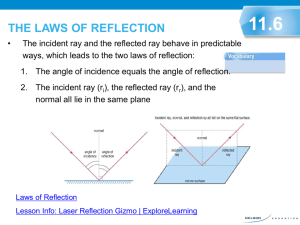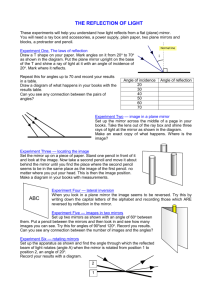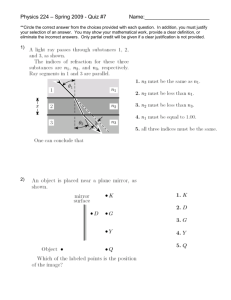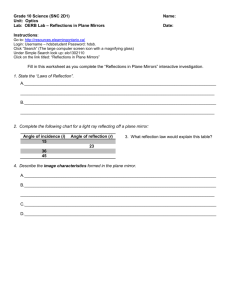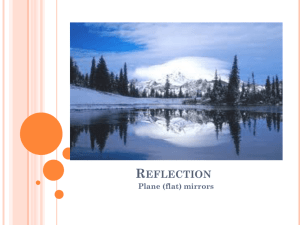Chapter 25: The Reflection of Light: Mirrors
advertisement
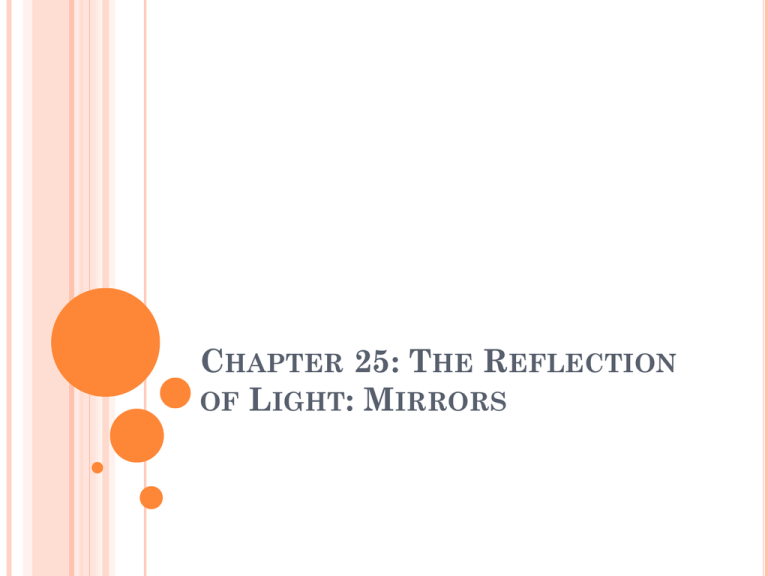
CHAPTER 25: THE REFLECTION OF LIGHT: MIRRORS WAVEFRONTS AND RAYS In describing the propagation of light as a wave we need to understand: wavefronts: a surface passing through points of a wave that have the same phase and amplitude. rays: a ray describes the direction of wave propagation. A ray is a vector perpendicular to the wavefront. TYPES OF REFLECTION Specular reflection- when parallel light rays strike a smooth, plane surface, the reflected rays are parallel to each other. (mirrors do this) Diffuse reflection – a rough surface reflects the light rays in all directions THE REFLECTION OF LIGHT Most objects reflect a certain portion of the light falling on them. For a ray of light incident on a mirror The angle of incidence, Ɵi , is the angle that the incident ray makes with respect to the normal The normal is a line drawn perpendicular to the surface at the point of incidence. The angle of reflection, Ɵr , is the angle that the reflected ray makes with the normal. LAW OF REFLECTION The incident ray, the reflected ray, and the normal to the surface all lie in the same plane, and the angle of reflection Ɵr equals the angle of incidence Ɵi Ɵr = Ɵi CHECK YOUR UNDERSTANDING Consider the diagram below. Which angle (A, B, C, or D) is the angle of incidence? ______ Which angle is the angle of reflection? ______ CHECK YOUR UNDERSTANDING A ray of light is incident towards a plane mirror at an angle of 30-degrees with the mirror surface. What will be the angle of reflection? PLANE MIRRORS 1. 2. 3. When you look into a plane (flat) mirror, the image you see has 3 properties: The image is upright The image is the same size you are The image is located as far behind the mirror as you are in front of it. The image is also reversed left to right PLANE MIRRORS 1. 2. 3. When you look into a plane (flat) mirror, the image you see has 3 properties: The image is upright The image is the same size you are The image is located as far behind the mirror as you are in front of it. PLANE MIRRORS A mirror is an object that reflects light. A plane mirror is simply a flat mirror. Plane mirrors are ground to be flat – the flatter the more expensive. (Typically good ones have no hills or valleys larger than 500nm). Consider an object placed at point P in front of a plane mirror. An image will be formed at point P´ behind the mirror. PLANE MIRRORS do = distance from object to mirror di = distance from image to mirror ho = height of object hi = height of image ho For a plane mirror: do = di and ho = hi hi do di IMAGES An image is formed at the point where the rays of light leaving the object either actually intersect or where they appear to originate. If the light rays actually do intersect, then the image is a real image. If the light only appears to be coming from a point, but is not physically there, then the image is a virtual image. IMAGES The image is called virtual because it does not really exist behind the mirror CHECK YOUR UNDERSTANDING To save expenses, you would like to buy the shortest mirror that will allow you to see your entire body. Should the mirror be (a) half your height (b) two-thirds your height, or (c) equal to your height? Does the answer depend on how far away from the mirror you stand? ASSIGNMENT Check Understanding: p 778 #1-3 Focus: p 792 #2, 4, 7 Problems: p. 793 #3-6
